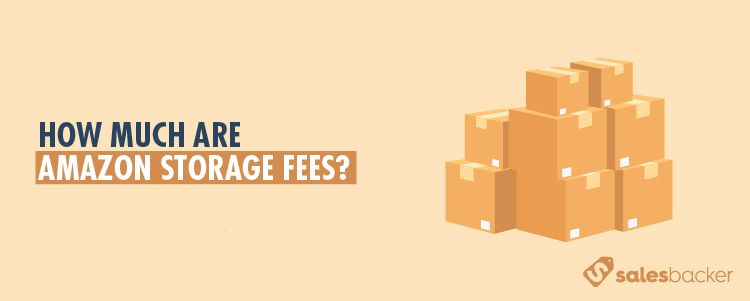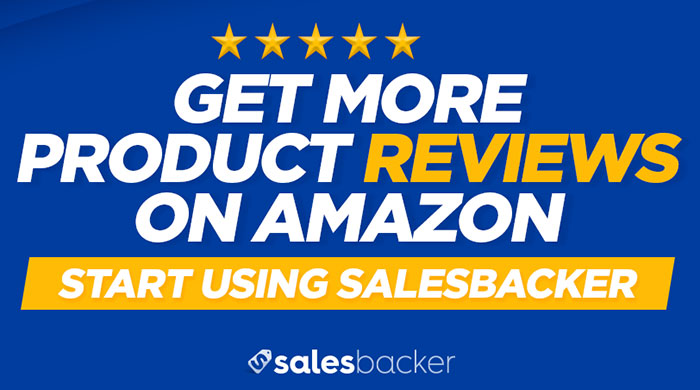Amazon storage fees are something every third-party seller should be educated about, because if you aren’t careful these fees can end up quickly eating into your margins, or even causing you to lose money on your product. You’ll need to regularly assess your storage fee risk and adjust your strategies to ensure you minimize their impact on your margins. Because if you haven’t already noticed, storage fees keep going up.
Amazon’s business is growing so rapidly that they can’t stay ahead of the demand for space in their fulfillment centers; as fast as they can build them, they fill them up. So, since space is in such high demand it doesn’t come free and if you aren’t careful it can quickly become quite expensive.
There are two types of storage fees to familiarize yourself with. But with both of these fees, the key to success and keeping profit margins high is smart inventory management.
Monthly Inventory Storage Fee
The monthly inventory storage fee is just another matter of fact cost of doing business with Amazon. Fulfillment center storage space is a valuable commodity at Amazon, and because of this the cost continues to go up as the demand goes up. So, when planning inventory, this is an important and costly factor to keep in mind. The more inventory you have in the warehouses, the higher your inventory fees will be.
How It's Calculated
This storage fee is calculated based on the daily average volume (in cubic feet) of storage space your inventory occupies in Amazon’s fulfillment centers. Amazon alone owns the calculation used to determine the fee you will pay, and they even specify this in Seller Central.
“Amazon reserves the right to make its own measurement of the cubic feet or weight of packaged units or representative samples. In the event of any conflict between an Amazon measurement and information provided by the seller, Amazon's measurement will govern.”
There are two categories of product rates; standard-size and oversize. While standard size items take up less space, the configuration of the space is at times more complex than with oversized products since Amazon often uses bins or drawers to more efficiently store the products. While the rate is higher for standard-size items, oversize items are usually still more expensive overall due to the fact that the fee is calculated using the volume measurement of cubic feet.

For more details, please see this page in your Seller Central account (requires login)
The monthly storage fee is applied to your Seller Central account usually between the 7th and 15th day of the month, to cover the storage fees for the previous month’s business. Rates vary depending on what time of the year it is — not surprisingly, rates go up significantly around the holidays when fulfillment center storage space is particularly valuable.
Long-Term Storage Fee
In addition to the monthly storage fee, twice a year Amazon charges an extra fee for any inventory that has been sitting in their warehouse for six months or more as of the inventory cleanup date. Because space is so limited in Amazon’s warehouses, Amazon wants the inventory that is sitting on their shelves to be used by products that are selling well. If a third-party seller sends Amazon a ton of inventory that then doesn’t sell, it is taking up space in the fulfillment centers that could be storing products that are making Amazon money. So, Amazon actively works to encourage third-party sellers to carefully manage their inventory to keep their warehouse space efficient and profitable.
How It's Calculated
The long-term storage inventory cleanup happens on February 15 and August 15, and there are two fee tiers; one tier is for inventory that has been in the fulfillment center for six to 12 months, and another tier for inventory that has been in the fulfillment center for 12 months or more.

For more details, please see this page in your Seller Central account (requires login)
How to Determine Which Units Are Potentially Subject to Long-Term Storage Fees
There are a few different ways to get a sense for which of your units may be subject to a long-term storage fee. Within Seller Central you can use tools to help you determine what your existing risk looks like so that you can plan a strategy for avoiding the fee if at all possible.
The first method that you can use is the FBA Inventory Age box within the Inventory Dashboard. You can access this tool by following these steps:
Within Seller Central, hover over Inventory and click on Manage Inventory.
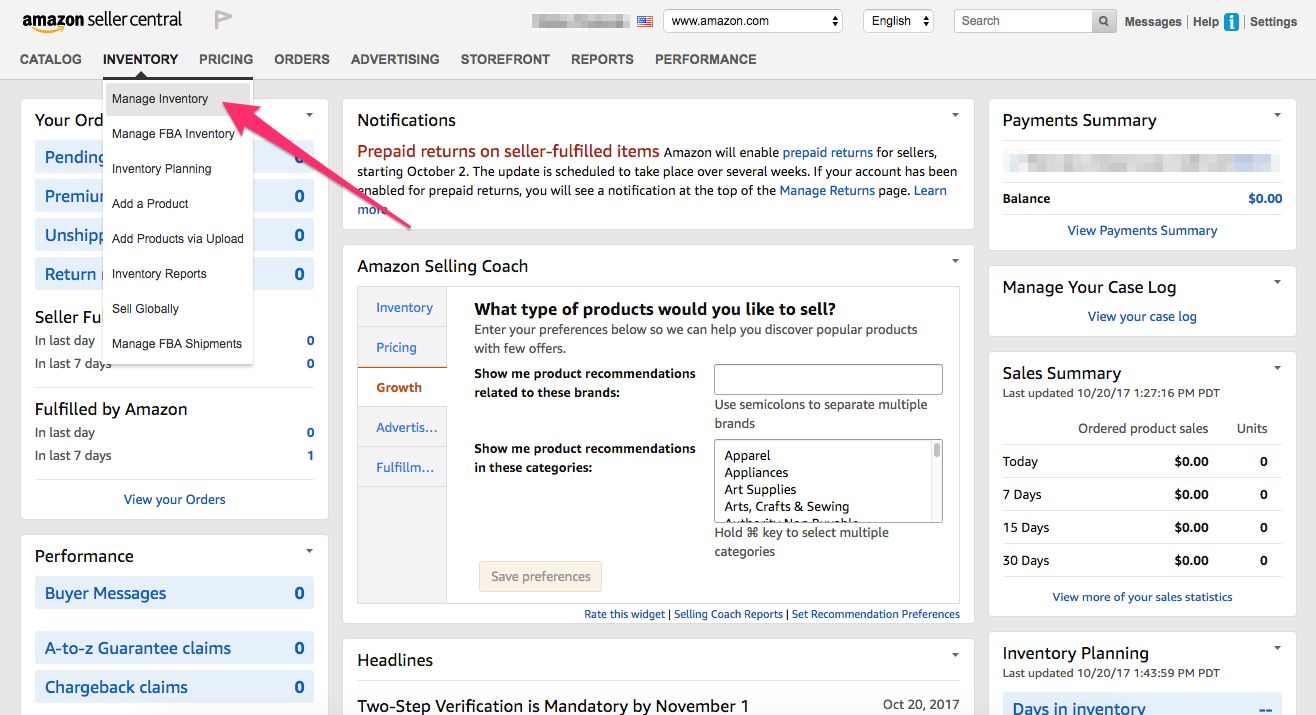
Click on Inventory Dashboard.
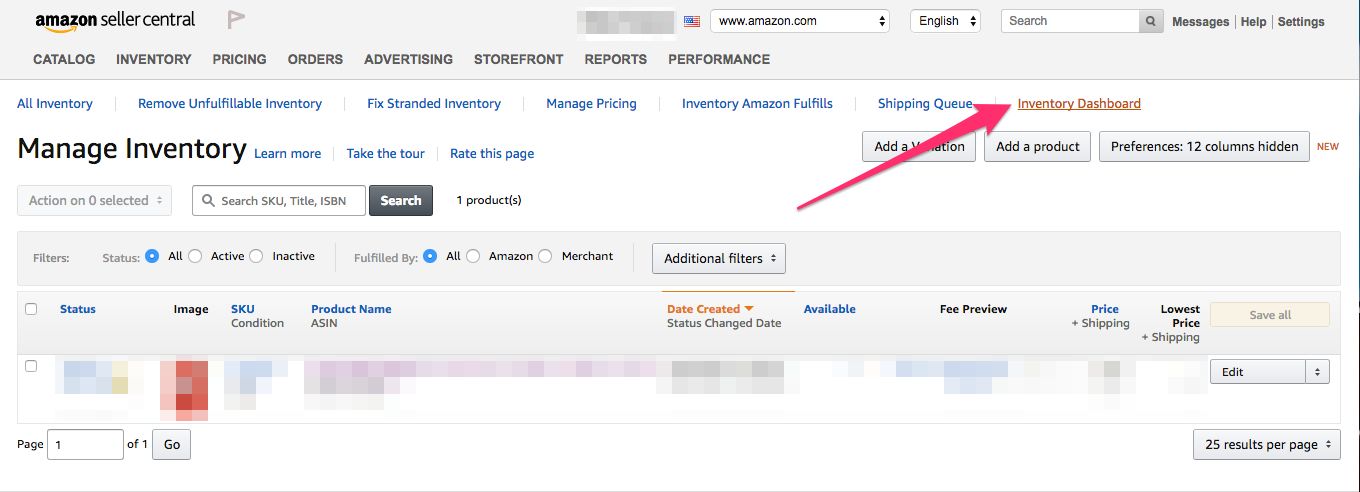
Scroll down until you see the FBA Inventory Age box. Then, click View Details.
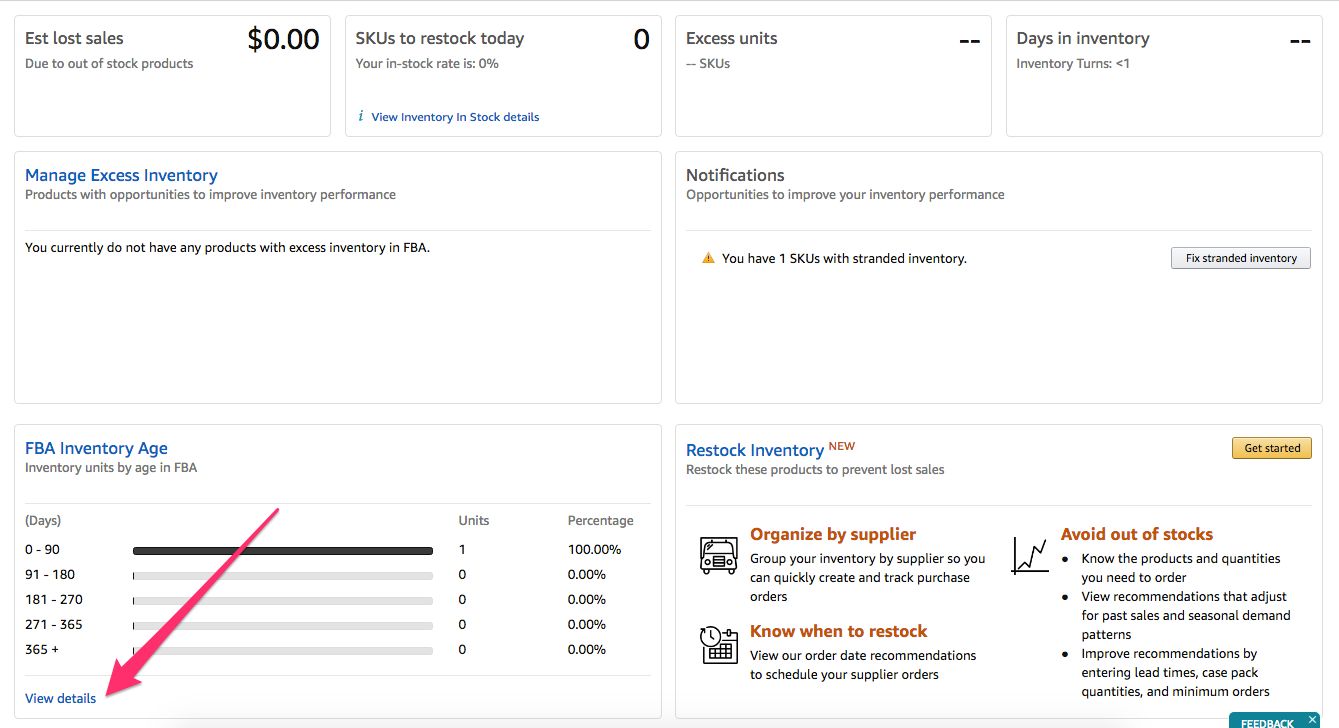
From here, you’ll find the estimated Long-Term Storage Fee as well as the inventory age for your units.

Another way to quickly get a sense for your long-term storage fee risk is to use the Inventory Health report in Seller Central. This report is helpful for seeing which units and fees fall into each of the two fee tiers (6-12 months, and 12 months+). To access this report, do the following:
Within Seller Central, hover over Reports, and click on Fulfillment.

Under the Inventory tab on the side of the screen, select the Show More, and then Inventory Health.
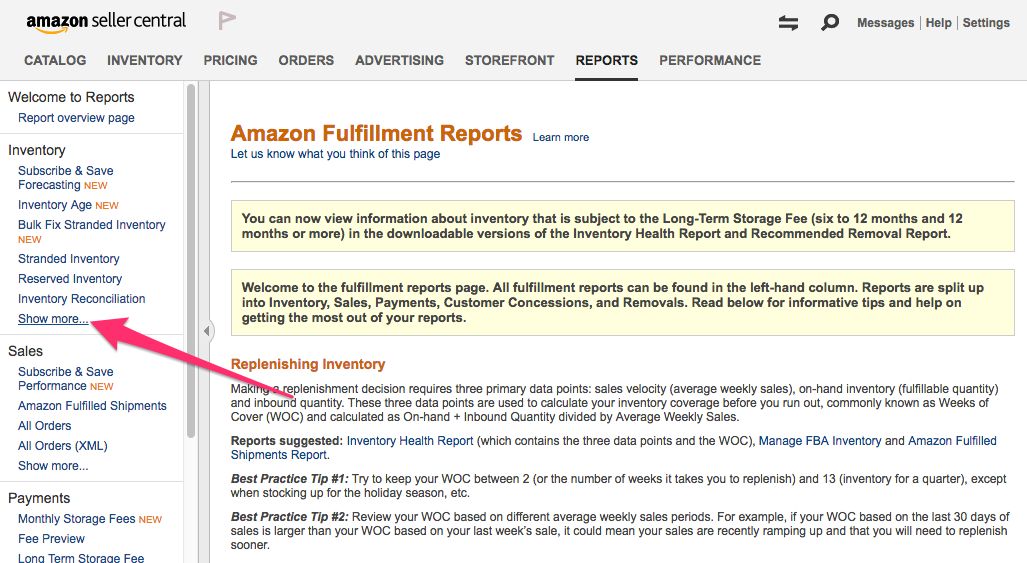

Within this report, there are fields indicating the number of units subject to a Long-Term Storage Fee within the 6-12 month tier and 12 months+ tier, as well as the estimated Long-Term Storage Fee for each tier.
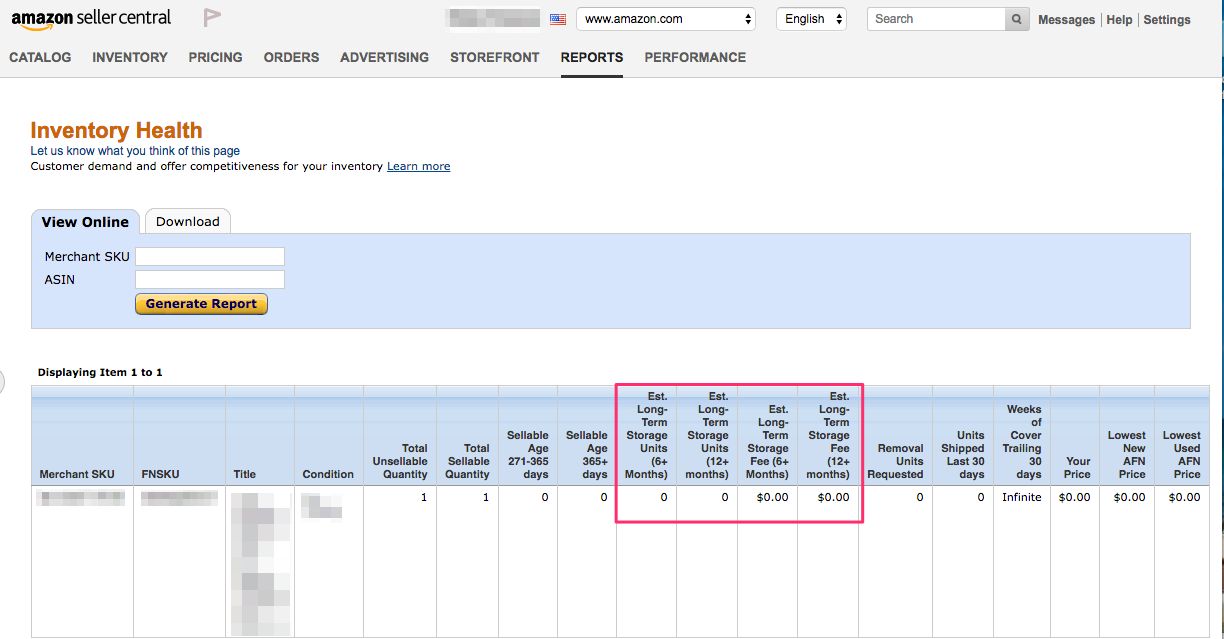
Best Practices for Avoiding Storage Fees
Use Careful Strategies for Stocking Inventory
When launching a new product, always plan to start with a small quantity of inventory until you get a sense of how quickly your product is selling. As a best practice, you should always avoid sending in more inventory than you think will sell in a six-month period. To give yourself the longest possible length of time to sell your inventory, plan to send in inventory shortly after the February 15th or August 15th inventory cleanup date, if you can. Of course, you always want to avoid running out of stock. But, when possible, you also want to avoid sending in large quantities of inventory right before an inventory cleanup date, since when the next inventory cleanup rolls around in six months all of your inventory that hasn’t sold will have just barely passed the six month mark, and will be subject to a long-term storage fee. It is best to send most of your inventory in shortly after an inventory cleanup date so that when the next inventory cleanup occurs your unsold inventory will not yet have hit that six month milestone. This essentially buys you another six months to sell your inventory before incurring a long-term storage fee.
Store Additional Inventory Outside of Amazon FBA
Another option for avoiding storage fees with Amazon is to keep a stock of inventory on hand in a location other than Amazon’s warehouses, such as your home, a storage unit, or another free or low-cost location. By keeping inventory stored in an easy-to-access location, you can keep lower volumes of inventory at Amazon and minimize storage fees, knowing that you can quickly ship off inventory to Amazon’s warehouses to avoid running out of stock when your inventory gets low. This approach gives you more flexibility when it comes to managing your inventory, versus always sending your full merchandise order directly from your manufacturer to Amazon. Particularly if your minimum order quantities are high, or your manufacturer is overseas, this approach can save you a lot of money.
Run Discounts on At-Risk Inventory
As you get closer to the twice-yearly inventory cleanup dates, if your sales projections show that some of your inventory is at risk for incurring long-term storage fees consider running a price promotion to move the inventory more quickly. Sponsored Product Campaigns and Headline Search Campaigns are another great way to increase sales volumes, if you haven’t already put these advertising methods to use.
Optimize Detail Pages to Grow Sales
Be sure that all of the components of your detail page are optimized to drive sales. Important details such as image quality and product description cannot be emphasized enough. Product reviews are also an important way to drive sales — the more you have, the more information potential customers have to make a smart purchasing decision. Be sure to sign up for Salesbacker to quickly and easily grow the number of product reviews for your listings. You can sign up today and receive a free 30-day trial.
Liquidate or Remove Inventory (If it Makes Sense)
If all else fails and the inventory cleanup date is just around the corner, consider liquidating some or all of the at-risk inventory, or creating a removal order to have the items returned to you or destroyed. The best way to determine whether or not this strategy makes sense is to do some math. Within the Inventory Health report you can get the projected long-term storage fees; add this fee into your profit margin calculations to determine the impact. If these fees are such that you will lose money by continuing to keep the items in Amazon’s warehouses, then using one of these strategies is probably a smart move.
To Wrap It Up
It is important to be strategic about your inventory management approach in order to minimize monthly storage fees and avoid long-term storage fees. While running out of stock is something you always want to avoid, having too much inventory can be just as detrimental to your business, if not worse. If you aren’t careful, these fees will not only erode your profit margins, but they can create a scenario where you are actually losing money on each sale of your product. So be sure to adopt strategic inventory management practices sooner rather than later, and save yourself a lot of headache when those inventory cleanup dates roll around every six months.
